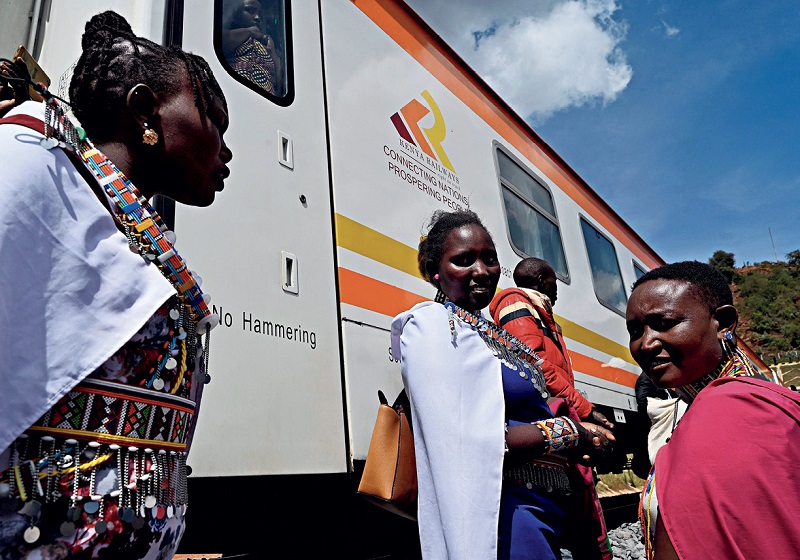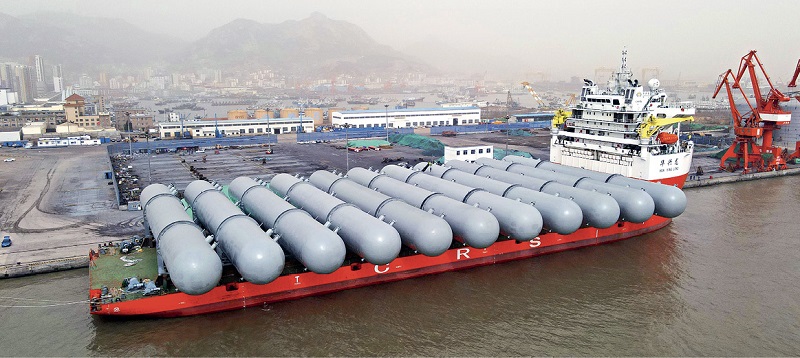The Belt and Road Initiative celebrates 10 years of success in Africa.

The first phase of the Nairobi-Malaba Standard Gauge Railway (SGR), built by a Chinese company, is open to the public in Kimuka, Kenya on October 16, 2019.
What began as a dream by the Chinese government 10 years ago has evolved across various parts of the world as a key catalyst for job creation and poverty eradication, resulting in economic growth and development. As the Belt and Road Initiative (BRI) celebrates its 10th anniversary, it has made a global impression as a vast and ambitious infrastructure development project whose main objective is to connect Africa, Asia, Europe and other regions via a network of roads, railways, ports and other key infrastructural developments.
At the inception stage, critics acted like a wet blanket towards the BRI, particularly on realizing that the growing Sino-African relationship was becoming a great force to reckon with. It became a point of ridicule to critics who label it “debt-trap diplomacy” and “debt colonialism.” But far from it, the BRI has witnessed a decade of inclusive infrastructure development programs in more than 150 countries, with more than 30 organizations supporting the initiative actively since it was launched in 2013.
Africa has been among the biggest beneficiaries of the BRI. In fact, statistics indicate that out of the 54 African countries, 52 have either signed or expressed interest to sign the BRI cooperation framework agreements and benefited from projects under this initiative, particularly those of roads, energy, ports, and communications infrastructural development. These projects are meant to open up African countries to trade by facilitating construction of key domestic and regional infrastructure, to help African countries to access affordable energy for industries and to open up efficient and reliable transportation channels for African exports to international markets.

Ultra-large liquefied petroleum gas storage tanks, manufactured by Shidao Heavy Industry, are shipped to Angola along the Belt and Road route from Rongcheng City, east China’s Shandong Province on April 11, 2023.
Trade Benefits
In Africa, the benefits of BRI cannot be gainsaid. For the last 10 years, trade has been on the front foot. The BRI has advanced steadily through Sino-African consultative forums such as the Forum on China–Africa Cooperation, which have opened up Chinese markets to exports from African countries. These forums are guided by the principles of extensive consultation, joint contribution and shared benefits for policy coordination, unimpeded trade, financial integration, facilities connectivity and people-to-people bond.
Sino-African relations have seen monumental growth in trade. According to trade statistics from China’s General Administration of Customs, the total trade between Africa and China surpassed the US $2 trillion mark since the BRI was initiated in 2013. In fact, China has been the leading trading partner for Africa. In 2022, the trade volume between China and Africa was recorded as US $282 billion, a significant growth of 11 percent compared to 2021.
Therefore, it should be noted that the BRI has been a major catalyst for growth of trade in most African economies, promoting trade through improved infrastructure. The connectivity created through construction and upgrading of roads, railways, ports and airports has improved transportation networks significantly by reducing logistical bottlenecks, lowering shipping costs and facilitating free movement of goods not just between Africa and China, but also within the African countries themselves. Additionally, the new infrastructure network on the continent has dismantled barriers to trade by creating trade corridors that connect African countries to global markets. It is these trade corridors that have become essential arteries for the free flow of goods, thereby making trade more efficient and cost-effective. This has played a pivotal role in reducing the market prices of these goods on international markets, making African exports competitive.
For instance, the construction of the Mombasa-Nairobi Standard Gauge Railway (SGR) in Kenya at a cost of US $3 billion by China has greatly reduced the time and cost of transporting goods from the port of Mombasa to other parts of the country and the region at large. The SGR has also been a good catalyst for promoting domestic and international tourism by facilitating more convenient and accessible movement of goods and people.
China’s grand plan is to increase its trade with Africa to US $300 billion by 2025. To show commitment towards this cause, the Chinese government has enacted a zero-tariff policy that covers over 8,800 different types of products, including clothes and footwear, agricultural goods and chemicals.

After graduating from university in 2018, Leah Uwihoreye founded an e-commerce platform in Rwanda, helping women survivors of Rwandan genocide sell handmade accessories.
Trade Milestones
The BRI has also opened up the African continent to trade through increased connectivity by way of digitization — encompassing the expansion of communication networks and the development of digital infrastructure. This has improved communication and access to information, especially in rural areas, catapulting most businesses to engage in both domestic and cross-border trade.
Just last year, the Chinese government waived tariffs on 98 percent of taxable imports from 18 African countries in two batches. This has ushered in an era of increased Chinese investments in the continent. In the last 10 years, according to statistics from China’s Ministry of Commerce, investments from China to Africa stood at US $3.4 billion with more than 3,000 companies investing in Africa. The value of newly contracted Chinese enterprises in African countries in the last 10 years exceeded US $700 billion, with completed turnover of over US $400 billion. The BRI has also been instrumental in ensuring development of economic zones and industrial parks along trade corridors in Africa. These zones are major magnets for foreign and domestic investors, thus stimulating manufacturing and processing for infant industries, resulting in creation of employment opportunities for the youth and boosting trade.
The BRI has achieved significant trade milestones in resolving potential trade impediments. For instance, the BRI has contributed to trade facilitation by improving transportation links and connectivity, reducing the turnaround transactions period and the cost of moving goods for trade between African countries. This has resulted in growth of trade volumes, which has benefited both the African economies and China. In addition, the partnership has also led to an increase in agricultural output and food security in Africa. Increase in output has been brought about by reduced post-harvest losses, guaranteeing adequate production for both domestic consumption and exports to global markets.
The future of the BRI in Africa is promising because it is the only surety for continued infrastructural development and increase in trade. The construction of more roads, railways, ports and energy projects is a sure bet for enhanced connectivity and trade between African countries themselves, and with China. If Africa has to fully industrialize and grow its trade fortunes, the industrialization strategy must align itself to the BRI in order to accelerate special economic zones and industrial parks, which are good incubators of trade, along the BRI corridors to attract more foreign investment, promote manufacturing and create employment opportunities for the youth. The future is bright. 
BENARD AYIEKO, a Kenya-based writer, is an economist, lawyer, consultant and a regional commentator on trade and investment.